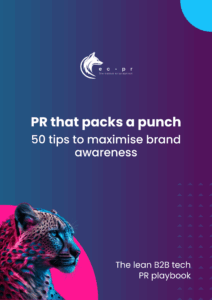
What a PR strategy cannot do for your ambitious tech business
To secure a sale, you need to create desire, a belief that your X will solve my Y. The higher the price tag of your X, the stronger my belief needs to be to close the sale – and the longer the likely sales cycle to embed that belief becomes, because belief is rooted in trust. Trust takes time to nurture.
A good PR strategy is designed to make your ambitious tech business visible, valued and understood by your target customers. Its purpose is to identify the manner and means and then deliver the message to influence target stakeholders; to get them to do or act in a way they may not have considered before.
Getting someone to act in a way they may not have considered before doesn’t happen overnight – you need to build trust through familiarity, relevance, and insight. This takes time and commitment.
There are three things a PR strategy cannot do:
- It cannot turn a bad product into a good one
- It cannot change organisational culture
- It won’t work if it’s based on lies
A dynamic PR strategy will not save a shoddy product
PR can help rebuild customer relations after a service interruption or problem, but unhappy customers will always share their feelings, and social media is a powerful megaphone. The more significant the gap between the experience and the reality, the worse the likely customer backlash. Angry customers expressing their shared grievances with vitriol or, worse, humour, can result in your brand being remembered for all the wrong reasons. Customers ridiculing your best efforts at trying to reclaim the high ground can result in a crisis.
In most situations, crises result from poor business practices – poor product design, delivery, health & safety, not faulty communications. Having a practical and practiced crisis plan in your back pocket will give you confidence when unexpected unpleasant events emerge. Sound communications can mitigate the effect of a crisis, but PR can do little in the face of unethical or short-sighted actions.
Brilliant, successful PR is rooted in truth. Repeated with pride and passion.
A PR strategy cannot change company culture
In the development phase of your PR strategy, you will receive insight that may highlight areas of weakness in your company culture. These weaknesses may repel potential customers, investors, or employees, which will hamstring your ability to compete effectively. Company culture can only be changed from the inside and from the top – it takes strong, resilient, visionary leadership to change company culture.
Victoria Wilson, of Exceptional Futures explains
“organisational culture consists of the beliefs and behaviours that drive how things get done at your company. When employees can connect with these beliefs and behaviours and adopt them as their own, they develop a sense of affinity with your organisation. If, however, they find themselves at odds with your cultural norms, there is a risk that they will fail to fit in and succeed.” After all, if your people fail, the business will falter.
Wilson continues:
“Cultural transformation is an ongoing process where you build an awareness of your organisation’s core values, identify situations where you are or are not in alignment with those values, and develop actionable plans to communicate and encourage the adoption of any necessary change.”
PR can play an essential role in the communication of cultural transformation to both internal and external stakeholders. It can help redefine your values and beliefs and articulate these in various compelling formats and stories. PR can shape how and when messages are communicated and provide the echo chamber, which ensures the message is repeated and reverberates wherever it is required. It cannot, however, lead or even champion, the change – that’s for the organisation’s leaders.
A successful PR strategy is rarely manipulative or deceptive
Most PR professionals are honest, hardworking, creative people who love communication, networking and building relationships – some of us are also hot on strategy development! Telling untruths, mistruths, not-quite-truths, yarns, fairy tales or porkies are as far from the reality of what we do on a day-to-day basis as you can possibly get. Misleading your target audiences to get attention will undo all the hard work you have invested in building up a good reputation and establishing credibility. In the words of Warren Buffet: “It takes 20 years to build a good reputation and 5 minutes to ruin it.”
Our role is to help build your narrative through creative storytelling rooted in truth which excites and ignites your audience with what you offer over and above the competition. This leads me to my next point – PR isn’t about lambasting your competitors. If you’re spending time criticising your competition, you are spending less time promoting your own unique selling points that make you stand out from them.
Brands that insult or belittle their competitors look desperate, disrespectful and untrustworthy and who wants to buy from a brand with those values and behaviours?
PR strategy – next steps
To start forming your PR strategy, reach out to our specialists today, and have a look at how EC-PR has performed for XTM International, a business delivering high-quality, enterprise-class translation technologies, in our tech PR case study.




